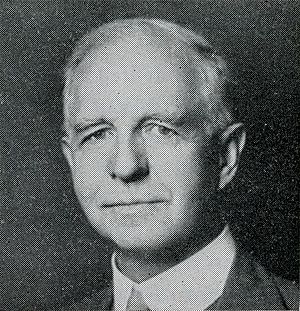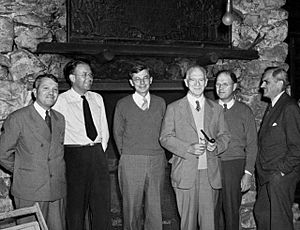Lyman James Briggs facts for kids
Quick facts for kids
Lyman James Briggs
|
|
|---|---|
 |
|
| 3rd Director of the National Bureau of Standards | |
| In office June 13, 1933 – November 5, 1945 |
|
| President | |
| Preceded by | George K. Burgess |
| Succeeded by | Edward U. Condon |
| Personal details | |
| Born | May 7, 1874 Assyria, Michigan, U.S. |
| Died | March 25, 1963 (aged 88) Washington, D.C., U.S. |
| Nationality | American |
| Spouse | Katharine Cook |
| Children | 2, including Isabel |
| Alma mater | Michigan Agricultural College University of Michigan Johns Hopkins University |
| Occupation | Engineer, physicist, administrator |
| Scientific career | |
| Fields | Applied physics |
| Institutions | |
| Thesis | On the absorption of water vapor and of certain salts in aqueous solution by quartz (1901) |
| Doctoral advisor | Henry Augustus Rowland |
Lyman James Briggs (born May 7, 1874 – died March 25, 1963) was an American engineer, physicist, and leader in science. He was the director of the National Bureau of Standards during the Great Depression. He also led the Uranium Committee before the United States joined World War II. Today, Lyman Briggs College at Michigan State University is named in his honor.
Contents
Lyman Briggs' Early Life and Education
Lyman Briggs was born on a farm in Assyria, Michigan. His family came from an early American settler who arrived in 1621. Lyman grew up helping on the farm and later became a teacher at the school his grandfather built.
At age 15, Briggs went to Michigan Agricultural College (now Michigan State University). He studied agriculture but became very interested in mechanical engineering and physics. After graduating in 1893, he earned a master's degree in physics from the University of Michigan in 1895. He then started his PhD studies at Johns Hopkins University.
In 1896, Briggs married Katharine Cook, whom he met in college. They had two children, Albert and Isabel. Sadly, Albert died as a baby. Their daughter, Isabel, later worked with her mother to create the famous Myers–Briggs Type Indicator, a personality questionnaire.
Also in 1896, Briggs began working for the US Department of Agriculture in Washington, D.C.. He continued his research at Johns Hopkins and earned his PhD in 1903. His research focused on how water vapor and salts are absorbed by quartz.
Studying Soil and Plants
At the US Department of Agriculture, Briggs led the Physics Laboratory. He was a new kind of scientist who studied how plants and their environment interact. He focused on how soil holds water and helped create the science of soil physics. In 1906, he developed a way to classify soil based on how much water it could hold. This was an early step in understanding how soil behaves. He also helped create a lab that studied plants. Briggs worked with Homer Leroy Shantz to understand how the environment affects how plants take up water. This work was important for the new field of ecology.
Briggs' Work During World Wars
Helping in World War I
During World War I, Briggs was asked to work for the Department of Commerce's Bureau of Standards. There, he helped create a special device for naval ships. This device helped sailors aim naval guns more accurately by knowing how the ship was rolling. It was so successful that it was used on many naval vessels.
Leading the National Bureau of Standards
In 1920, Briggs officially joined the National Bureau of Standards. He led a division that studied engineering physics, including sound and mechanics. He hired Hugh L. Dryden, and together they studied how airfoils (like airplane wings) behave when moving very fast. This research was key to designing better airplane propellers.
Briggs also continued his interest in navigation. With Paul R. Heyl, he invented the Heyl–Briggs earth inductor compass. This compass used the Earth's magnetic field to help airplanes find their direction. For this invention, they received the Magellan Medal in 1922. This compass was used by famous explorers like Admiral Byrd on his flight to the North Pole and Charles Lindbergh on his first flight across the Atlantic Ocean.
In 1933, during the Great Depression, Briggs became the director of the National Bureau of Standards. It was a tough time, and he had to cut costs. He worked hard to save jobs by having employees work part-time or transferring them to other organizations. He also focused on projects that had a direct economic impact. Thanks to his strong leadership, Congress increased funding for the Bureau in 1935, and many employees were rehired.
The Uranium Committee and World War II

In 1939, President Franklin D. Roosevelt asked Briggs, who was 65, to lead the Advisory Committee on Uranium. This committee was formed to investigate the possibility of splitting uranium atoms, following a letter from Albert Einstein and Leó Szilárd. At first, progress was slow, and the work wasn't focused only on military uses.
Meanwhile, in the United Kingdom, scientists found that it might be possible to make a powerful bomb from a special type of uranium. They sent reports to Briggs. In 1941, a British committee concluded that an atomic bomb was "not only feasible, it was inevitable." They also noted that Germany was doing nuclear research. Britain, already at war, wanted the U.S. to help with this urgent project.
A British scientist, Marcus Oliphant, visited the U.S. in 1941 to find out why the American committee wasn't moving faster. He discovered that Briggs had kept the important British reports in his safe and hadn't shared them with his committee. Oliphant then met with the whole committee and strongly urged them to focus all efforts on building the bomb. As a result, in December 1941, a full-scale effort to develop atomic bombs began, which later became the secret Manhattan Project.
During World War II, Briggs helped the Bureau of Standards focus almost entirely on war-related work. They developed things like the non-rotating proximity fuze (a device that makes a bomb explode when it's near its target) and worked on guided missiles. They also researched important materials like optical glass and synthetic rubber. Briggs changed the Bureau's culture from being open to being very secretive because of the war effort.
Briggs retired in 1945 at age 72. He was honored for his 49 years of service to the government. In 1948, President Harry S. Truman awarded him the Medal of Merit for his important work during World War II.
Later Life and Discoveries
After retiring, Briggs continued his scientific research. He set up a lab to study how fluids behave under negative pressure. This was connected to his earlier work on how plants take up water. In a famous experiment, he measured how much tension a column of water in a tube could withstand before breaking. His findings were published and are still important today.
Briggs also loved baseball! During World War II, baseballs were made with cork instead of rubber. People complained about the new balls, so Briggs tested them. In 1945, he showed that the new baseballs were not as good. He also studied how a pitched baseball curves. With the help of two pitchers from the Washington Senators baseball team, he used a wind tunnel to study how spin and speed affect the ball's path. He even attached a lightweight tape to the ball to count its spins! This research was very popular in newspapers and is one of his most well-known findings.
Briggs was also very involved with the National Geographic Society. He chaired their research committee and helped with two stratospheric balloon flights. One of these flights broke the altitude record in 1936. In retirement, he led an expedition to study a solar eclipse in Brazil. He often wrote articles for the National Geographic Magazine.
Lyman Briggs passed away on March 25, 1963, at 88 years old. He was known for his wide range of interests and his calm, steady personality. In 2007, Michigan State University honored him by renaming the Lyman Briggs school to the Lyman Briggs College.
Awards, Honors, and Distinctions
Positions:
- Philosophical Society of Washington, President, 1916
- Washington Academy of Sciences, President, 1917
- Federal Specifications Board, Chairman, 1932
- Federal Fire Council, Chairman, 1933–1939
- National Bureau of Standards, Director, 1933–1945
- National Geographic Society, Life Trustee, 1933–1964
- Special Advisory Committee for Stratospheric Balloon Flights, Chairman, 1935–1936
- National Conference on Weights and Measures, Chairman, 1935
- American Physical Society, President, 1938
- Uranium Committee S-1 of the National Defense Research Committee, Chairman, 1939
- Research Committee of the National Geographic Society, Chairman, 1937
- National Advisory Committee for Aeronautics, Vice-chairman, 1942
- National Bureau of Standards, Director Emeritus, 1945–1963
Honorary doctorates by the following institutions:
- Michigan State College in Science (1932)
- South Dakota School of Mines, Engineering (1935)
- University of Michigan, Law (1936)
- George Washington University, Science (1937)
- Georgetown University, Science (1939)
- Columbia University, Science (1939)
Briggs received the following honors:
- American Philosophical Society, Magellanic Premium (1922)
- National Academy of Sciences, Elected Member (1942)
- Medal of Merit by President Harry S. Truman (1948)
- Franklin R. Burr Award, National Geographic Society (1954, 1962)
Served as president of:
- American Physical Society
- Washington Academy of Sciences
- Philosophical Society of Washington
- Cosmos Club, Washington, D.C.
- Federal Club, Washington, D.C.


